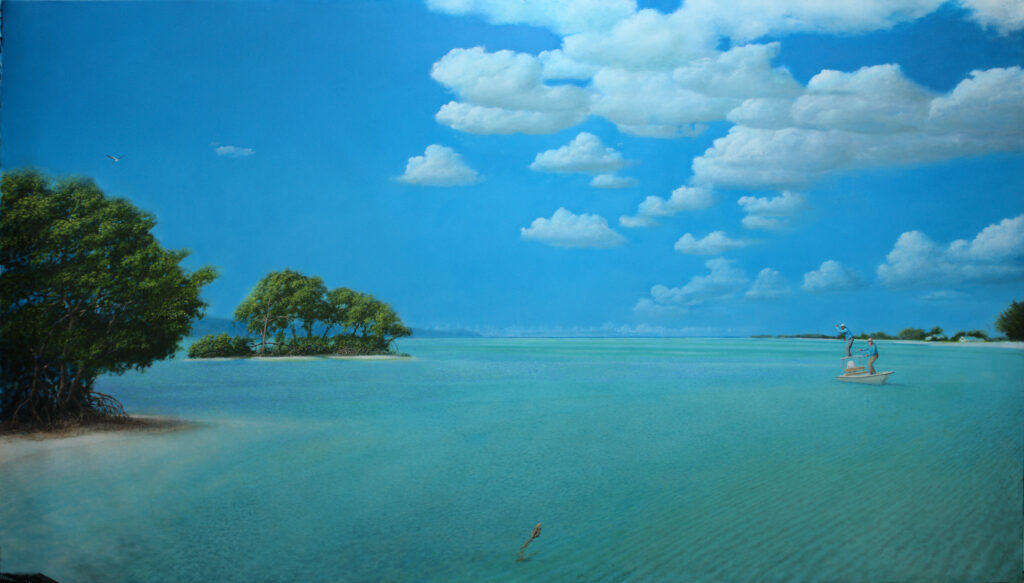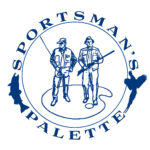Stage 04.1 – Bringing the Composition to Life

Another unique aspect to Cardnell’s approach to Sporting Art is the size at which he is willing to work. He is not afraid to create an image on a grand scale and feels, in doing so, he can bring the viewer into the image and make the viewer feel as if he or she is actually a part of the overall setting. He feels most of his subjects warrant a large format to fully experience the setting as it should be – a grand discovery process. His pieces have a true ‘Masterpiece Feel’ to them when viewing in person. While Cardnell offers the paintings are best viewed at about 10 feet, his works all hold up very well at 20 feet or two feet. The attention to every detail in the process allows for this and the viewer’s experience is equally dramatic at any viewing distance.
Cardnell: As you can see, I’ve added the ‘principal pair,’ which I will work upon again later.
Lighter notes have now been added into the sea from the horizon down to a line that approximates a horizontal drawn from the gunnel of the skiff. I’ve gone no lower with these lighter notes as they will now quickly transition from small horizontal lines into 2 dimensional shapes. I expect this to be a long, tedious and repetitive process but it will transform the image.
I’m now into Stage 04. The first task will be to correct some errors in the sky and clouds that have been annoying me for some weeks. I will introduce the Bonefish and seabed debris. Then I will enlarge the dry sand outcrop beneath the largest mangrove cluster before beginning the process of overlaying the lower areas of seabed with the sharp, bright highlights. These should begin to bring the composition to life. All further passes will correct what should be minor errors and enhance detail to reduce the acceptable viewing distance from 20 feet to less than ten feet.
I’ve been working intensely on the sky area and have applied two complete coats over an area larger than half of the canvas. Not easy since it’s a very large area and I’m trying to represent aerial perspective with a warmish tint to the clouds at the top of the canvas, graduating to colder tones as they approach the horizon. I’m also graduating tone in the clear blue areas of sky and this task specifically needed 2 coats. This of course means over-layers cannot be applied until an under-layer is dry or almost dry. The modelling of clouds isn’t as smooth as I would like it to be, and colors are a little disunified, although, I feel the geometry is convincing. Anyway, an intermediate image update is likely over the weekend once the current layer is dry and I can apply highlights and detail. Smoothing will be for one more pass before the final.
I believe I’ve done enough on the sky to move on. I smoothed out the graduation from deep blue at the top of the canvas to light blue on the horizon. Unfortunately this will need to be done again as, in the process of smoothing out, I lost some of the deepness of blue in the top left corner. The clouds have been a challenge because they require a lot of white pigment so these areas are correspondingly slow to dry. Still more work, mainly smoothing, is required.
As a task to keep busy while the paint dried out I included a Sooty Tern towards the left of the canvas above the first mangrove cluster. Also in the center of the canvas, close to the bottom edge, I have started to map out a barnacle-encrusted anchor, lodged in the sand. This is the start of my including various items of debris before adding our Bones shoal – Maybe a starfish and a few rocks, but no more than six items altogether.
I’ve started to detail the skiff and generally tidied up around that area. Lot more work to do in that respect.
Moving forward on Stage 04.2 I will include the other debris items mentioned and I hope to add the majority of Bonefish. I will re-establish the top-leaves of the mangroves, which were subdued by my over-painting the sky. I will then adjust the profile of the sand beneath the first mangrove outcrop to bow-out rather than bow-in.
